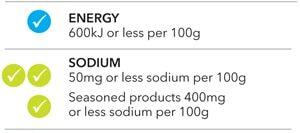
Oven-baked frozen wedges and fries can be a better choice than deep fried. But how do you know which ones are a healthier choice?
What’s available?
Wedges and fries come in many shapes and sizes. Some are flavoured or salted, while others are plain with no added salt. There are also sweet potato/kumara fries among the traditional potato products.
Energy
Every 100g of plain potato contains around 320kJ. Add oil during cooking and the energy goes up to around 400kJ. We found frozen wedges and fries that ranged from 510kJ to 850kJ per 100g. To keep our meal balanced with one quarter carbs, one quarter protein and half low-energy veges, without getting too high in kilojoules, we recommend choosing wedges or fries that contain 600kJ or less of energy per 100g.
Sodium
Many wedges and fries have added salt or seasonings. On some products, the flavourings are obvious, but on others we had to read the ingredients list to see they weren’t plain potatoes or kumara. Choosing no-added-salt products means you can be more in control of what you’re adding at the table. The amount of sodium you get from salted fries, sprinkling salt at the table, and from sauces quickly adds up.
We recommend choosing unseasoned wedges or fries with 50mg or less sodium per 100g. If you’re choosing a seasoned product, choose one that’s 400mg or less sodium per 100g, and keep these as occasional choices.
How to choose
Use these criteria to compare frozen wedges and fries:

www.healthyfood.com










